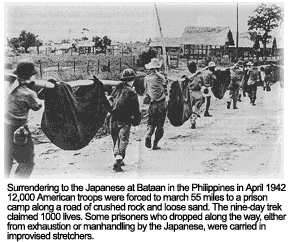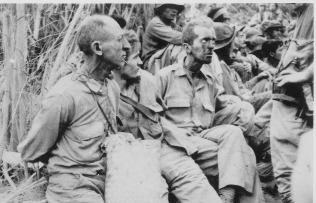Most of the resistance took place around the Manila Bay with the Battle of Bataan beginning on. What is known for sure is that a majority of the deaths were Filipino soldiers.
Bataan Death March march in the Philippines of some 66 miles 106 km that 76000 prisoners of war 66000 Filipinos 10000 Americans were forced by the Japanese military to endure in April 1942 during the early stages of World War II.

Bataan death march facts tagalog. Bataan Death March 75000 na mga Pilipino at Amerikanong sundalo ang kabilang sa Martsa. Most civilians who did this were killed by Japanese soldiers. Ang Death March ay ang pagpapalakad sa mga sundalong Pilipino at Amerikano mula Mariveles Bataan hanggang San Fernando Pampanga ng wala sa kanilang pinakain o pinainom kayat ang iba sa kanila ay namatay sa daan.
5000-10000 filipino soldiers died during the march. The only place where the. Army Transport Grant to the Philippines.
Gordon was an American soldier who participated in the Bataan Death March. For some the march took six days but for others it took over a week to make the full trek to Camp ODonnell. Gordon - Captured American soldier Richard M.
On the morning of April 9 1942 following four months of intense battle and no hopes of reinforcements the American troops on the Bataan Peninsula of the Philippines surrendered to the Japanese. American prisoners use improvised litters to carry comrades too weak to walk along the road. Noon ang estasyong daang-bakal ay lugar ng paghinto para sa mga Pilipino at Amerikanong bilanggo ng digmaan prisoners of war noong naganap ang Martsa ng Kamatayan sa Bataan noong 1942.
File Photo from Wikimedia Commons 3 The Death March started from Bataan and made a stop-over in San Fernando Pampanga where the POWs were loaded onto waiting box cars that took them to Tarlac. Ang Martsa ng Kamatayan sa Bataan Ingles. The Bataan Death March began on April 10 1942 when the Japanese assembled about 78000 prisoners 12000 US.
Although researchers still debate the numbers it is reasonable to conclude that several thousand Filipinos and several hundred Americans were killed on the march with as many as 30000 dying of disease within weeks after entering captivity. April 1942 The surrendered Filipinos and Americans soon were rounded up by the Japanese and forced to march some 65 miles from Mariveles on the southern end of the Bataan. An actually number is impossible to determine as it is believed some were able to escape into the jungle with others being captured at a later time.
Ang bilang ng mga sundalong maysakit at sugatan ay dahil sa sakit sugat o kayay pinatay sa saksak sa bayonete habang lumalakad ng walang pahinga pagkain at tubig. And about 1000 american soldiers died. Bataan Death March Facts.
Bataan Death March Facts - 7. Bataan Death March. The Bataan Death March.
The Bataan Death March took place in the Philippines after General George MacArthur left the Philippines Islands with most of the American forces leaving some behind to fight to fight alongside the Filipinos against the Japanese. The captured American and Filipino men were then subjected to the Bataan Death March a torturous march of more than 65 miles in. The Bataan Death March was Japans brutal forced march of American and Filipino prisoners of war during World War II.
The 63-mile march began on April 9 1942 with at least 72000 POWs from the southern end of the Bataan Peninsula in the Philippines. Bataan Death March Facts. He was stationed at Fort Slocum for 3 months before he too the US.
The American and Filipino troops were vastly outnumbered by the invading Japanese and their commander General Douglas MacArthur and following the fall of Manila January 2 1942 ordered their retreat to the Bataan Peninsula The memorial was designed and sculpted by Las Cruces artist Kelley Hester and is located in Veterans Park along. People Involved - Bataan Death March 1. Dubbed the Bataan Death March by its survivors estimates of 7000 to 10000 deaths occurred along the route.
Mainly starting in Mariveles on the southern tip of the Bataan Peninsula on April 9 1942 the prisoners were force-marched north. Soldiers who broke away from the pack for a drink of water were killed. The troops had few supplies and conditions led to men being hit with various diseases such as dysentery scurvy and malaria.
Ang mga sundalo ay galing sa mga nabihag noong labanan sa Bataan. Noon ang estasyong daang-bakal ay lugar ng paghinto para sa mga Pilipino at Amerikanong bilanggo ng digmaan prisoners of war noong naganap ang Martsa ng Kamatayan sa Bataan noong 1942. Bataan Death March Facts - 5.
It was in Bataan that the bulk of Filipino and American forces stood their ground to defend the Philippines until they were forced to surrender on April 9 1942 due to a shortage of ammunition food and medicines. The Japanese made conditions worse by making the prisoners sit in the hot sun for several hours without any shade or water. Walang awa silang pinagpapapalo kapag nagpapahinga.
The Bataan Peninsula was an arduous terrain consisting of jungle and mountain regions. Bataan Death March. Although they didnt know it their destination was Camp ODonnell north of the peninsula.
They then marched again for 14 to 20 kilometers to their internment camps at Camp ODonnell in Capas Tarlac. Historically the old PNR train station was the site of a stopping place for Filipino and American prisoners of war during the Bataan death march in 1942. The Bataan Death March was when the Japanese forced 76000 captured Allied soldiers Filipinos and Americans to march about 80 miles across the Bataan Peninsula.
The Battle of Bataan lasted from 7 January 9 April 1942 3 months and 2 days. Historically the old PNR train station was the site of a stopping place for Filipino and American prisoners of war during the Bataan death march in 1942. Bataan death march.
The march took place in April of 1942 during World War II. According to PBS its estimated that between 9000 and 16000 Filipino soldiers died and between 650 and 2300 Americans died during the Bataan Death March. Since the prisoners only received little food and no water many local Filipino civilians would try to throw food at them while they were marching.
They began marching up the east coast of Bataan. Upwards of 500 Americans and 2500 Filipinos are considered to have died during the march. Facts continued thousands died from disease starvation dehydration heat prostration untreated wounds and wanton execution.
Gordon became a soldier in 1940. Interesting Facts - Bataan Death March.

World War Ii For Kids Bataan Death March
Tidak ada komentar